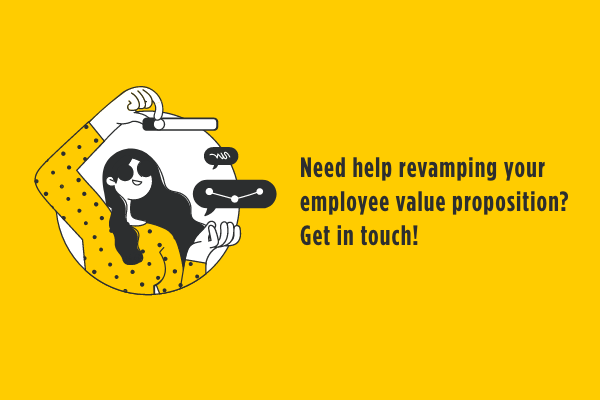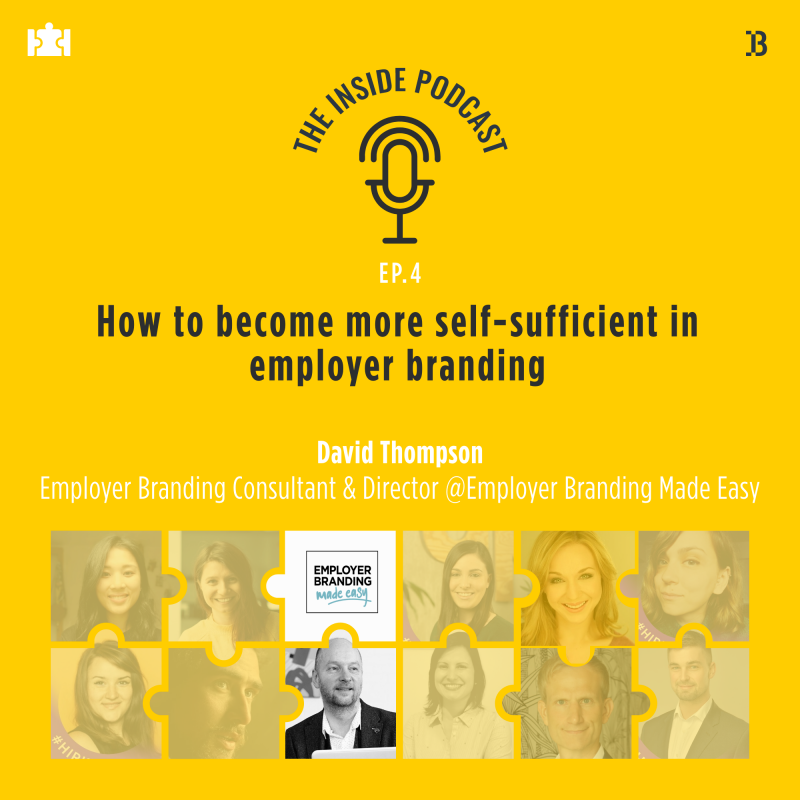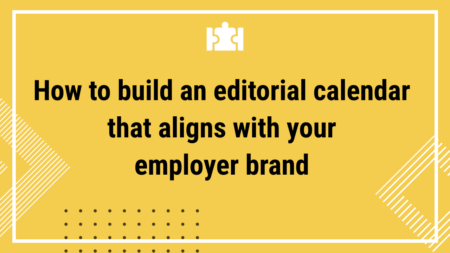Overview
Did you know that sometimes you just need “good boots” to make your employees happy?
In today’s episode, we’ve had the pleasure of interviewing David Thompson, Employer Branding Consultant & Director at Employer Branding Made Easy. We talked about the importance of listening and understanding the needs of your people. David shared with us some valuable insights on the benefits of employer branding. Believe it or not, they go far beyond cost and transactional savings.
What you’ll learn by listening
- The benefits of employer branding go beyond cost & transactional savings
- Employer branding: it’s not just a nice-to-have but a critical pillar of any resourcing strategy
- Sense of purpose, the key to a strong company culture
- The role of data in crafting an employer branding strategy
- Tips on converting job seekers in an industry (tech) where nobody is looking for a job
- Integrations among functions across organizations
- Employer branding and people marketing matter just as much as brand marketing
- Steps to engaging your audience at an emotional level through storytelling
About the company
“With 20+ years of recruitment marketing, EVP and Employer Branding experience we’re confident Employer Branding is the single most powerful investment in your talent acquisition strategy, but it’s sometimes seen as a dark art.”
Employer Branding Made Easy is on a mission to level the playing field, removing the mystery to make employer branding skills accessible to everyone regardless of budget, company size, and whether their company is a household name. It’s all about telling your story in a way that is compelling, authentic, standout and attractive.
Do it well and you’ll also save time and money while growing a reputation as an employer of choice.
Enjoy listening to [S02Ep04] of The Inside Podcast!
[S02Ep04] – podcast transcription
Georgiana: Hi everyone! This is Georgiana and you’re listening to Employer Branding: The Inside Podcast. Today I’m talking to someone who is neither from Romania nor from Germany, but from England. David Thompson, welcome to our podcast. I’m so happy to have you here today.
David Thompson: Hello, Georgiana. It’s lovely to be on. Thank you very much. I’m very excited to be speaking to you.
Georgiana: David has been an employer branding consultant and director for Employer Branding Made Easy for a while, but has worked in employer branding and in recruitment marketing for about 20 years. So I am sure, David, you have a lot to share. But before we get to talk, please tell me exactly what your role entails and what your daily duties involve?
David Thompson: Yeah. Thanks, Georgiana. So, this is David Thompson. I’ve worked in employer brand agencies for more than 20 years. And I got to a point, a few years ago, where I love employer branding, but I felt there wasn’t enough knowledge shared within the industry. So I set up my own little business called Employee Branding Made Easy. And what we do is help organizations to up their game in employer branding, and become self-sufficient.
We’ve developed a series of online courses that people can go through to learn more until they become self-sufficient. And then, we support them with some consultancy and coaching for their teams as well. It’s all about helping organizations become more self-sufficient in employer branding.
Georgiana: Employer branding Made Easy. Is it usually hard? And how can companies be persuaded to invest more time and interest into building a professional employer brand?
David Thompson: It’s a good question. Is it hard? I think it’s being made a lot harder than it needs to be. In all honesty, I should have called the company Employee Branding Made EASIER. But yeah, I think it’s been made hard. I think the agencies who people turn to tend to keep a lot of the knowledge very close to their chests. They don’t want to share it, obviously, because that’s how they make their money.
I’m finding that there’s a lot of demand for employer branding skills within organizations, but not many places to get those skills. The skills themselves are not that hard. You just need someone to show you what to do. You need to process and be able to understand how to do things. It’s hard when you don’t know what you’re doing. But it’s not so hard when you don’t know what you’re doing. It’s all about getting more education out there. And hopefully, that’s what our courses do.

As for how people can be persuaded to invest more time? Well, that’s a really interesting one, isn’t it? I think we all kind of inherently know employer branding is a good idea. But sometimes, actually proving it works can be a different matter. In the world of recruitment, we still live in a very transactional world, where we’re used to paying a certain amount of money and seeing an instant return for a hire.
Employee branding can be a little bit more elusive than that. It takes time to work. Sometimes you don’t instantly see a hire for it because it’s more about influence than about instant results. But there are lots of great statistics out there that you can use to back up your business case. You know, if you look at things like LinkedIn, for example, there are stats that will show you the savings that can be made, the increasing levels of engagement that can be achieved.
You could apply these bits of research to your own company in your own statistics. So that’s my kind of observation from my time. If you want to get interest within your organization, you really need to show some kind of financial measures, because everybody is still very much transactionally driven. But actually, the reality is that employer branding benefits are far more than just cost savings and transactional savings, at a far more long term.
Georgiana: As I was telling you before we started recording David, it’s basically the same issue that I’ve had for years when it comes to digital marketing, to content marketing and to see results, and to how long it takes before you actually see some results. So it’s good that you said it, maybe people will understand that this is what it is and that it actually requires time before you can say that it worked.
David Thompson: Yes, it needs time and a bit of a leap of faith. A little bit of trust that it will work, basically. It’s gone beyond the point, for me, employer branding of being a nice to have, that you can do if you’ve got some spare cash, or you know, or that it’s just for big organizations. To me, we’re at the point now where if you do not have a strong employer brand – and this is what I’m seeing from all of my clients that have been speaking to, whether they’re SMEs, big organizations – if you don’t have a great story to tell, and you aren’t telling it well, you are going to struggle to find talent. It doesn’t really doesn’t matter what sector you’re in at the moment. It’s gone beyond being a nice-to-have, and it’s now an absolutely critical pillar of any resourcing strategy.
Georgiana: David, you’ve worked with many, many companies these past years. Could you say that there are sectors in which companies are more open towards considering employer branding?
David Thompson: Yeah, I think there are. They tend to fall into two categories. For me, one is need-driven. There are certain sectors where there is kind of chronic skill shortages, where recruiters have just reached the end of their rope. They need to do something else because the current methodologies don’t work anymore. They tend to be in the UK, certainly at the moment where I do most of my work in tech.
There are huge skill shortages in tech. Conventional measures of posting jobs on job boards just don’t work. So tech is one, care and healthcare are another. In this country, it is another major sector. We have an aging population. And there are simply not enough people to meet the needs of work in care and healthcare. That’s a sector where there’s a high demand as well.
And the other kind of category they fall into is organizations that are already used to the idea of branding as a principle. And a good one is retail. So retail organizations generally realize, “Okay, well we stand or fall on our brand”. Therefore, transferring those principles from brand marketing into employer branding is an easier journey. So, yeah, I’d say tech, care, and retail are probably the three areas where I do most of my work. But having said that, there’s still engineering, construction, all sorts of other sectors where there’s still a lot of work going on as well.
Georgiana: Got it. Well, David, while talking to HR managers across Germany and Romania, it is more and more clear to me that a thriving company culture is a flexible, open one where the most valuable assets are stunning colleagues. Do you agree? Or do you disagree with the Netflix philosophy?
David Thompson: I agree to an extent, Georgiana. I think, as a statement, it’s kind of correct. You know, stunning colleagues. Absolutely. Everybody wants stunning colleagues. But I think the reality is not everybody can have stunning colleagues. It works for Netflix because obviously, you know, they have the cool tech startup-type vibe. It absolutely works for them. But if I’m a small manufacturing company, outside Berlin, does that work for me? Not so much.
So I think the idea of a flexible, open culture is great. But sometimes employees need a little bit more guidance than that. They just want to come in and do their job, and do their job effectively. It works for some, and not for others. For me, what I’ve seen universally, is that it doesn’t matter what kind of company you are, or what kind of people you’re employing. If those companies manage to communicate your sense of purpose, have everybody in the organization connected to what we’re doing, why we’re doing it, and what this will mean for everyone. That, to me, seems to be where strong company cultures come from.
It’s a sense of purpose. Organizations that have a sense of purpose, it doesn’t matter where they are or what they do, they seem to do better and have happier employees, and organizations with happier employees perform better. So that would be my observation on that one.
Georgiana: I think that’s really interesting and useful input. And, David, how much do you and your company take data into account when developing an employer branding strategy? And what kind of data?
David Thompson: Yeah. We use data as the absolute pillar, the bedrock of our employer brand strategies. I’ve always said, employer branding without research is guesswork and pretty pictures, nothing more. Employer branding started off being very creatively driven, “I just want something that looks nice”. But I think it’s matured over the years. And we’re now at a point where we’re saying, that’s just at the surface. It needs to be data-driven to be effective.
We focus on three types of data, three types of research when we’re putting together our strategies. The first one is competitor research and competitor data. We make sure our employer brand strategies are kind of differentiated from the competitors. There’s no point in producing lovely materials and a strong EVP if you are saying exactly the same as everybody else. We know we need to create differentiation. So we do that through competitor audits, and measuring, very carefully what the competitors are saying and doing, and making sure we’re doing something different.
The second bit that often gets overlooked in employer branding and is critical is external audience data, understanding your audiences really well. What matters to them? What do they need? What do they expect? What they’re looking for, from their employment experience? Far too often employee brands are driven from the inside out. We kind of say things that we want to say without stopping to think, “Is that what our audiences want to hear?”
So we do lots of external audience surveys. We’ve come across sections of audiences of the type of candidates our clients are looking for. And we use that to drive a lot of our strategy. Are we saying things that are really going to hit an emotional key with our audiences? So external audience research is our second phase.

Our third phase is internal data. We use data from engagement surveys. But we also mix that with other internal surveys, and with focus groups, and executive interviews. We pull together all of this data and then spend time analyzing and making sense of it. We could say, what do we need to say to be different? What are our external audiences looking for? So what can we say that’s going to be really pertinent? And then what have we got internally? What’s our story? What can we say that’s authentic, real, but compelling, as well? And all of this together helps us to build our kind of MVP framework and our employer brand strategy going forward. So yeah, data is becoming ever more important in employee branding.
Georgiana: But David, would you agree with this statement? “Most companies are data rich, but information poor”?
David Thompson: Yeah, that’s a really good question. Data-rich, but information poor. Again, I agree to an extent. In my experience, larger organizations tend to be data-rich and information-poor. So they will have an ATS, they will have all kinds of data pouring into that. They will have talent pools of candidates. But they have no idea what to do with it. It’s their data, at the end of the day. It just kind of sits there. And they don’t learn from it. They don’t learn anything about their marketing strategies from it.
But I’d also say when you look at smaller organizations, they are data-poor and information-poor. There’s just no data whatsoever. Many organizations I speak to are still treating resourcing and recruitment on a roll by roll, very transactional. We’ve got a job, we’ll advertise, we’ll go to an agency, we’ll fill it, we’ll put a candidate in place, and then we move on. And we learn nothing. We don’t learn from our previous mistakes, we don’t have a strategy to kind of figure out how we’re going to fill the next three years worth of talent needs.
So there’s no data and there’s no information, and they get trapped in a cycle, doing the same thing over and over again, with decreasing returns to scale. It’s working less and less, and they can’t quite figure out why; they don’t quite know what to do next. Having knowledge, data, information at hand is the starting point of starting to build a proactive resourcing strategy that will kind of pull you out of this endless loop of just being dependent on agencies and job listings that are working less and less.
Georgiana: Absolutely, absolutely. I also agree that, in general, data and information also can be powerful currency. But only if you know how to use it wisely.
David Thompson: Exactly, only if you know how to make sense of it, shape it, and use it. That can be a tough part, and sometimes you can get overwhelmed with data as well. Sometimes you just got so much; there’s too much data to make sense of. It’s all about finding the right data, the stuff that’s really gonna matter.
Georgiana: And I think, David, at the end of the day, it all comes down to the fact that there’s just a single person managing the employer branding part in a company. And that poor fellow is tasked with speaking to their colleagues and doing their engagement strategies and maintaining company culture. And then I guess data just remains lying around without really being used and looked at.
David Thompson: Absolutely, yes. I think only the biggest organizations have, as far as I can see at the moment, employer brand teams. I’m seeing an increasing number of organizations having an employer brand manager in place. But as you said, they’re a single person, and it’s almost too much for a single person to get their head around. So, what we’re going to see going forward, as needs grow more – which I’m convinced they will – are more robust teams and more defined teams. So you’ll have an employer brand analyst, you know, data analyst, specifically assigned to that job, rather than just giving everything to a single person and asking them to be all things or people.
Georgiana: Exactly. You know, we had people that mostly work with tech companies who are having trouble attracting and retaining their workforce. Would it be too strong of a statement to say that employer branding for tech is a different breed of employer branding?
David Thompson: No, I don’t think it would be too strong of a statement, Georgiana. I think that’s true. And I think that is down to availability and supply of talent. If you look at employer branding, in most sectors, we’re still in a position to convert job seekers. So it’s people who perhaps have picked up on a job listing or have seen some information, but they are in the market, they are looking for a job. And our job is to make sure that they choose our organization and not the competitors. It’s about converting active job seekers. In tech, nobody is looking for a job. Nobody. The jobs come to them, in tech. They are absolutely used to 100 agency approaches every day.
Georgiana: They’re spoiled in that way.
David Thompson: Absolutely! They don’t have to look for jobs. They are overwhelmed with job offers pretty much all the time. So you have to adopt a very different tactic. It has to be far more of a push marketing strategy. You have to work very hard to not only get over “Hi, I’m here, and we’re recruiting”. You’re not converting pre-existing job seekers, you are trying to get to people who have probably no interest in moving jobs, or are bombarded with job offers every day. So you have to adopt very different tactics.
Georgiana: You know, David, I think I’ve asked this question, every guest that I’ve had on my podcast. I’m asking you as well. How do companies thrive in these blurry times? What have you discovered to be companies with successful strategies in Corona times?
David Thompson: Wow, yeah. That’s the million-dollar question. There’s an easy answer to that one. What I have seen that has worked in these blurry times, is that those organizations – they don’t necessarily have to be the best organizations; they don’t have to have incredible cultures – that are able to tell their story with honesty and authenticity will be winners; the good storytellers.
The ones that have worked hard to understand what their unique differentiating offer is. So they’ve got a clear EVP well defined. And they’ve just built the ability to tell good stories, and stories that don’t just work on a kind of functional level. So they’re not just stories saying, “Hey, here’s our salary, or benefits”. The winners will be the companies that can create an emotional engagement with audiences. So they can really get to the heart and make people feel something; the ones that can tell stories about how THEIR people feel about working for their organization; what it’s done for their lives, how it’s enhanced their lives.
Those organizations that can create that emotional engagement with their candidate audiences are the ones that succeed. But do that and go back to the research part we were talking about earlier on. It’s those organizations that understand what their audiences want as well.
They understand their target audiences and what their hopes and fears and their needs are from their roles. And they understand how to tell their stories to create an emotional impact on those audiences. Those businesses that can do that are the ones I’ve seen who are succeeding.
And then it’s really interesting because I was working with a client a few weeks ago. We did competitor research. We were looking at their competitors. And the ones that seem to be succeeding had some of the lowest Glassdoor scores. So they weren’t the best employers. They were the best storytellers. My partner was working with the highest Glassdoor score of all of them and struggled most to recruit because they weren’t good storytellers. So I think, organizations that have figured out how to tell emotionally driven stories are the ones that will succeed in these blurry times.
Georgiana: I’m so glad you mentioned storytelling because as someone who’s worked in content marketing for many years, I get to understand more and more the power of good storytelling, in marketing and employer branding, and basically in all these areas that haven’t really looked at it so far, and that haven’t really grasped its power.
David Thompson: There is science behind this, isn’t there? When we give people a series of facts, like here are our salaries and here are our benefits, it’s kind of processed by the neocortex part of the brain; the bit that remembers the facts. But it doesn’t remember them for very long and isn’t very compelled by them. But when you’re telling more emotional stories, it’s dealt with by the limbic part of the brain, which creates a hormonal impact. So you feel it more, and you remember it more, and you’re compelled to take action as a result. So there really is a kind of science behind it.
Georgiana: Exactly, exactly. And I’ve been following the people at Contently for a few years now. They have a lot of books and they have this newsletter on the power of storytelling and where it will take you if you follow it religiously and apply it into all areas of your company, marketing and HR and talent acquisition and everything. So yeah, I’m once again glad you brought this up. David, what do you think is in store for employer branding once people get back to the physical office?
David Thompson: The short answer to this is, I think employer branding is becoming more and more important, and will really grow hugely over the next couple of years. I believe there are three reasons for that. Firstly, I think candidate behavior over the last few years has changed. All the stuff that we’ve been talking about, candidates are now looking far more for the kind of information on cultures, on fit, on ethical stance than they’ve ever been before.
It’s no longer enough just to talk about salary and benefits, you know, they’re looking for much more. I think the skill shortages, as far as we can see at the moment, are just gonna get worse. And that we seem to be, we thought we were going into a deep recession caused by COVID. We’re going to be bouncing out of that very, very quickly. And demand in nearly every area seems to be pretty high. So I think skill shortages are going to drive demand for candidates even more.
I think we’re only going to partly go back into the office. Most organizations are going to adopt a kind of hybrid model where people are going to work from home some of the time. And I think that will create some danger for employees. Yes, it creates brilliant cost savings for them, but it could also weaken the bonds that we have with our employees.
We’re not in the physical office as much anymore, and the bonds we have with our employees are weakened. Employer branding is a key way of making sure those brands stay strong, you know; great storytelling about why we’re an amazing place to be and why you’re in the right place, I think it’s gonna become increasingly important. So those three things I think, are going to drive the importance of employer branding more.
We’re gonna see the need growing, growing, and growing. I also think we’re coming to a point where there’s going to be a bit of a transition in who manages the employer brand, and how it’s managed. I think it’s traditionally as we talked about before, kind of sat in the realm of resourcing and one person has done it, an employer brand manager, recruitment marketing manager. But I think there’s going to be more and more integration across functions within organizations with marketing and consumer branding, becoming more and more involved as well.
We’re seeing lots of consumer brands now understanding that actually, you know what employee branding and people marketing is just as important as our brand marketing. It’s going to grow across functions more. There’s going to be more co-working between HR resourcing, marketing, internal communications. So it’ll become more of a broader kind of function than just sitting purely in resourcing. So I think it’s got to go through a really substantial change over the next few years. It’s going to be a really exciting journey.
Georgiana: Like I was saying before, we’re sort of riding the wave. So let’s see what happens now.
David Thompson: Absolutely. Yeah. I’ve seen more change in employee branding in the last five years than I saw in the previous 15-20.
Georgiana: Exactly. David, what is your most endearing success story so far?
David Thompson: Oh, that’s a good question. My favorite story to tell has nothing to do with cost savings, or increase hits on websites. It’s to do with the value of really understanding your people and listening to your people. So, I was working last year with a retailer. They have a huge distribution center in the middle of the UK. And they were having some struggles with their engagement statistics.
Their engagement surveys weren’t shedding very much light on why that was. I ran a series of focus groups with people who were working in that distribution center. What came out was they had cold feet; the boots that they were wearing were insufficient. And as a result, they were pretty unhappy. But the question was never asked in the engagement survey – how are your feet. You can only get that by going and talking to groups of people. And what we found, as a result, I kind of went back to their head office and reported back to their leadership and said, “This is what I found”.
And they sat up and took notice and said, “Oh, goodness, we had no idea”. So they acquired new boots for people. And since then, their engagement scores have risen quite considerably. And it’s something as simple as that. But it just shows the value of listening and understanding the needs of your people. But not just depending on an engagement survey. Really listen to your people. And if you act on it, you will get their faith, they will work harder, and your business will be better for it. So that’s my favorite little story.
Georgiana: It’s a bit like one of the client stories that we’ve had in the past at Beaglecat. I remember working with a tech company in Romania. And the employees were really unhappy with their office chairs, which is something that we find out by simply addressing the question – what is it that you don’t like about your current work environment? It’s a simple survey.
David Thompson: A simple thing, but you need to listen and you need to act. And if you do that, you could raise engagement and your employees will be happier, and they’ll stay longer.
Georgiana: Yeah, it’s just the little things sometimes. Well, David, this has been really, really nice. And now we’re actually approaching the end of our podcast. And so I’m going to ask my last question. A question that I asked all of my guests. And that includes a resource that helped you and that you could recommend to our listeners in employer branding, but not necessarily.
David Thompson: Well, firstly, I’m gonna say employerbrandingmadeeasy.com, our website. We write a lot of blogs and thoughts and tons of opinions on employer branding. That’s a good source. The other place I love is a website called Employer Brand Wagon. It is musings of some top employer branding people, case studies on their experiences, thoughts on where employee branding is going next. If you want to shape your thinking on what a great strategy looks like, where everything is going, what you need to be a great employer brand manager; that’s a really good source of information. So I can recommend that one as well.
Georgiana: Super cool. Thank you so much, David. This has been really fun. I thank you once again for joining me on Employer Branding: The Inside Podcast. And I wish you the best of luck in shaping the industry. I hope to meet you in Berlin or at an employer branding conference.
David Thompson: It’s been really lovely speaking to you. Thank you. Yeah, the podcast goes from strength to strength. It’s really great to hear people sharing more knowledge. Thank you so much.
Georgiana: This was Employer Branding: The Inside Podcast. You can find our podcast on Spotify, on Apple Podcasts, and content on employer branding-related things on employerbranding.tech. Until the next time stay tuned. Bye!







